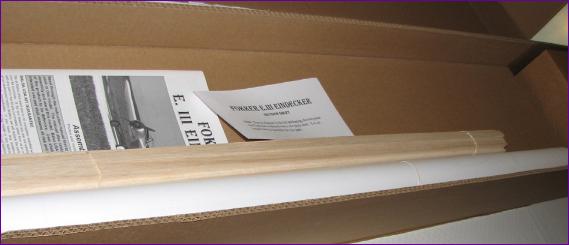|
Neindecker Project Diary
I started thinking about a subject for the 2015/16 building season quite early, and after some deliberation, decided that I would like to build a Flair Hannibal. I have nothing of this era in my hangar and can remember admiring a couple of these mock WW1 aircraft performing lazy aerobatics and touch 'n' gos.
Those were i.c. powered but of course mine would be an electric conversion. Also, at 91in span, I would want to build it with a two piece wing. It also occurred to me that it would make a good aerotow tug which should add an extra dimension to the project.
Then the problems started. Over the next two months or more, it transpired that there was no realistic prospect of Flair producing any more of these kits in the forseeable future and all attempts to locate one on a shelf somewhere came to nothing. However, during this searching I came across the Balsa USA kit for a Fokker Eindecker. This is slightly smaller than the Hannibal at 80in wingspan, but is very similar in character. A bit more seearching revealed that there seemed to be only one kit in the country so, still smarting from the disappointment with the Hannihal, I felt that an uncharacteristically prompt decision was called for and so ordered the kit.
On opening the box, my first impression was that there had been a major packing error! The only visible contents were the rolled plans, an instruction booklet, errata sheet and a small bundle of strip wood. |
||
 |
||
However, after a few seconds of panic, I realised that the box had a false floor. Removing this showed a much more hopeful array of parts.
The box proudly proclaims "Quality AAA Balsa". Well, unless "A" is a hardness rating, I beg to differ. The wood is generally very heavy and the grades are inconsistent, with variations of over 2:1 in the weight of identical parts. On the good side though, the strip wood is straight and the die cutting is very clean, so it does look as if the kit should go together well.
I do try not to start a winter build before September but the early arrival of the kit, coupled with a less than brilliant English summer, presented a significant temptation. In the end, whilst I managed to restrain myself from getting out the glue and scalpel, I did unroll the plans and start contemplating various modifications.
Over the years, many people have 'kit-bashed' the Hannibal to make it into a more scale-like representation of an Eindecker. My mission was the opposite - I didn't want a scale build and so set about looking for areas where I could personalise the model, the aim being to keep the period feel but make it clear that it wasn't meant to be a representation of an Eindecker. Perhaps predictably, the project soon became known as the Neindecker!
Apart from the electric conversion and aerotow role, there were a couple of attractive features of the Hannibal which were missing from the Eindecker, notably the triangular tail surfaces and the lovely aluminium cowl. The tail surfaces could be changed with a few strokes of a pencil and scalpel but the cowl issue demanded a little more research. After considering scouring the shops for a suitable saucepan, I eventually bought a cowl for a Flair Baronette (yes, there are a few Flair parts still available). Initially the wrong cowl was supplied with an open front. The photos show the differences between the three cowls and it is clear that the front end of the model will need to be re-worked considerably for it to fit. But then, it's not a scale model, so that doesn't matter at all!! |
||
|
||||||
|
||||||||||||
|
||||||||||||||||||||||||||||||||||||||
|
||||||||||||||||||||||||||||||||||||||||||
|
||||||||